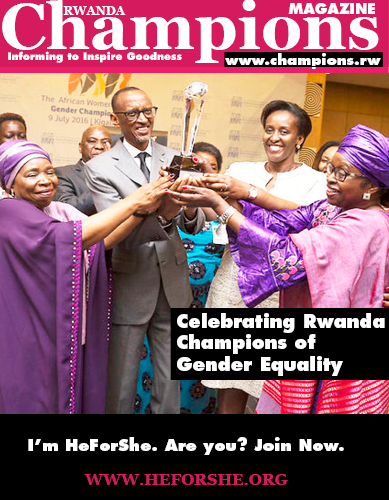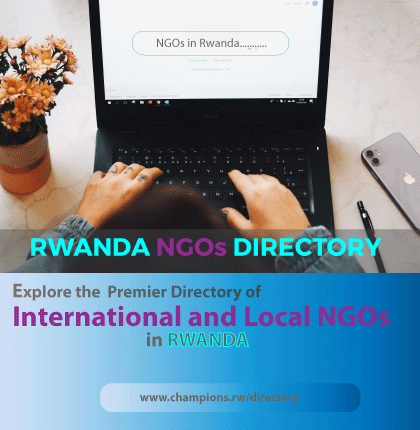African Women Leaders Urge Unity to Bridge Gender Gap in Leadership
African women leaders are calling for greater solidarity and collaboration to help more women attain leadership (…)
The gap between financially included Rwandan men and women is narrowing as more women embrace financial services, steering the country in the right direction towards achieving gender equality in the uptake of financial products, FinScope Rwanda Gender Thematic Report 2020 has revealed.
Released in March 2021 by Access to Finance Rwanda(AFR), the report shows that financial inclusion gender gap decreased from 4% in 2016 to 1% in 2020, reflecting growth in the use of financial products and services among the female population.
According to the report, 92% or 3.6 million Rwandan female population aged 16 years and older were using financial products in 2020 from 86% in 2016. Financial inclusion among the male population rose to 93% or 2.9 million in 2020 from 90% in 2016.
Overall, national financial inclusion rose from 89% in 2016 to 93% in 2020 or 6.7 million people, putting the country on track to achieve 100% national target by 2024.
Although the report indicates that more women were gaining financial inclusion, it also notes that men are still dominant users of financial products.
The report says that there is an opportunity for further growth and improvement to narrow the gender gap, especially in terms of deepening financial inclusion beyond access and moving towards a greater level of formal inclusion.
The gender analysis in the uptake of financial products/services was conducted as part of the FinScope Rwanda 2020 Survey with the aim to identify and address gender financial inclusion inequalities, by acknowledging differences between and among women and men, based on the unequal distribution of resources, opportunities, constraints, and power. It also aimed at promoting better-informed, gender-responsive and effective interventions.
The findings were based on a sample of the adult population in Rwanda aged 16 years and older. A total of 12,480 face-to-face interviews were conducted from September 2019 to November 2019.
DRIVERS OF FINANCIAL INCLUSION AMONG WOMEN
Formal financial products
The report indicates that the female adult population who have or use products or services from financial institutions increased from 63% in 2016 to 74% in 2020, while the formally served gender gap decreased by 3% since 2016, driven by the surge in the number of female population using informal financial services.
However, a very large portion of the population, 80% (3.1 million), which is an increase from 71% in 2016, have or use products or services from financial institutions that are not regulated or use community-based organisations or mechanisms to save or borrow money.
Banking
The report indicates that the total female adult population who have or use products orservices from licensed commercial banks increased from 24% in 2016 to 34% (or 1.3 million) in 2020. However, men are more likely than women to be banked, with 39% of men and 34% of women, showing a gender gap of 5%.
A high uptake of banking financial products and services among women working in the formal sector (90%), was reported albeit they lag their male counterparts in the formal sector by 6%. Surprisingly, women business owners (51%) are less likely to have a bank account compared to men business owners (58%), according to the report. Usage of banks among women is mainly driven by the uptake of savings accounts, as well as current or cheque accounts. Furthermore, women show a high level of cross-selling within the sector (i.e. multiple accounts, and multiple banking products per client).
The report further says that the increase in the number of banked women is driven by women who opened bank accounts in their own names, increasing from 12% in 2016 to 19% in 2020. Around one in five or 700,000 women have bank accounts in their own name, while an additional 15% or half a million women use bank accounts indirectly, either through using banking channels (over the counter) or someone else’s account, but they do not have a bank account in their own name.
Informal Financial Services(Non-banking)
According to the report, a large portion of women (71% or 2.8 million), have or use products or services from financial institutions that are regulated through acts of law but are not commercial banks. This is mainly driven by the uptake of mobile money, as well as the continued increase of Umurenge SACCOs, where 32% of members are women compared to 37% men. The gender gap between men (80%) and women (71%) served by other formal financial institutions (non-bank) decreased by 9% since 2016, but the gender disparity remains high.
FINANCIAL PRODUCTS EVER USED
The report shows that women are more likely to use savings groups (54%) than men (49%). The uptake of almost all other financial services is lower for women than men, especially mobile money operators, where the gender gap is 7%. A very low percentage of both genders has ever used insurance financial products, which could be an opportunity if the right product is offered that addresses insurance needs.
Mobile Money
As cellphone access and usage continues to increase in Rwanda, the report shows that an estimated 84% of women own or have access to a cell phone (compared to 90% men). As such, the uptake of mobile money has also increased significantly since 2016 with 66% of men (an increase from 45% in 2016) and 55% of women (an increase from 33% in 2016) having or using a mobile money account.
Although many adults initially opened a mobile money account because they trust it (42% of women and 44% of men) and it is affordable (35% of women and 39% of men), some also feel that it helps them to keep money safe or to save (21% of women and 25% of men). However, there is an 8% gap between registered mobile money usage by women relative to men. Women who have registered a mobile money account increased from 29% in 2016 to 50% (1.9 million) in 2020.
Savings and Investments
The report shows that men and women in Rwanda have similar attitudes towards savings and investments. However, women are slightly less likely than men to go without certain things so they can save. Interestingly, savings are the leading product type and one of the main drivers of financial inclusion for women in Rwanda.
In total, 85% of women save (compared to 87% of men) mainly to pay for living expenses when times are hard, which relates to the high incidence of no/low/irregular income. In turn, 15% of women do not save, mainly because they do not have money to
save or invest.
Borrowing and Credit
Overall sentiments towards borrowing between men and women are aligned with no gap. 76% of men reported that they have borrowed, relative to 77% of women. Men are more likely than women to borrow money for developmental reasons (such as business, building/improving dwelling, living expenses, farming equipment/expenses, livestock) at 60% and 36%, respectively.
In turn, 23% of women do not borrow mainly because they do not need to or because they are worried that they will not be able to service their debt. This may partially point to interest rates or knowledge of how credit works.
Insurance and Risk Mitigation
More women have taken out insurance products since 2016, when only 8% of women were covered by insurance, compared to 15% or 0.6 million in 2020 compared to 19% of men. This is mainly driven by the uptake of medical insurance at 30% (compared to 38% of men).
Remittances
Around 41% (1.6 million) of women in Rwanda either sent or received money from people living in a different place (within the country or outside Rwanda) compared to 49% or 1.5 million men. The most common mechanism used to transfer money is through formal channels.
Around 2% of women still send or receive money in cash through friends/family or deliver it in person, down from 7% in 2016.
FINANCIAL NEEDS
Around three in five adult women in Rwanda have a transaction account through either mobile money and/or a bank account. There is a gender gap of 9%, with women with transactional accounts at 62% compared to 71% of their men counterparts.
However, the gap is reduced when it comes to using these devices for digital payments. 29% or 1.2 million adult women use digital financial services compared to 31% or 0.9 million of their male equivalents. Men (58%) are more likely to be meeting life goals than women (50%).
FINANCIAL HEALTH
About 63% of women build and maintain reserves through saving money and investing in assets and businesses.
There is a slight gender gap compared to men with 65% of men building and maintaining reserves. Women are less likely to plan and prioritize (50%) compared to men (58%). This could be caused by the fact that they are more likely to use their livelihoods to meet resilience and liquidity needs compared to their men.
Close to 80% or 3.1 million adult women in Rwanda are credit active and 67% are in a healthy position to manage their debts, with only 33% showing signs of credit stress or over-indebtedness. The gender gap in relation to managing debts is trivial at 1% in favor of men.
RECOMMENDATIONS
Whereas there has been remarkable progress in bridging gender gap in financial inclusion, the report recommends taking further actions to ensure more women are financially included.
Some of the key recommendations include continuous monitoring and evaluation of national gender policy and girls’ education sector strategic plans which have proven successful in driving financial inclusion; support to women entrepreneurs and enabling others to start businesses; putting emphasis on usage and the quality of financial services; information dissemination of financial sector policy recommendations; dedicated training or financial education programme targeted at women to increase their financial literacy and supporting digital financial services to boost their usage especially among women.
African women leaders are calling for greater solidarity and collaboration to help more women attain leadership (…)
Women for Women International (WfWI) has appointed Nigerian development expert Thelma Ekiyor as its new global chief (…)
Minister of Gender and Family Promotion, Consolée Uwimana, told rural women Wednesday that living in the countryside (…)
Rwanda’s First Lady, Jeannette Kagame, has been honored with the FIGO Distinguished Recognition Award in Women’s (…)

